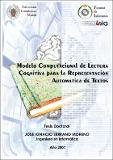Por favor, use este identificador para citar o enlazar a este item:
http://hdl.handle.net/10261/3697COMPARTIR / EXPORTAR:
 SHARE
BASE SHARE
BASE
|
|
| Visualizar otros formatos: MARC | Dublin Core | RDF | ORE | MODS | METS | DIDL | DATACITE | |

| Título: | Modelo computacional de lectura cognitiva para la representación automática de textos |
Otros títulos: | A Computational Model of Cognitive Reading for the Automatic Representation of Texts | Autor: | Serrano Moreno, José Ignacio | Director: | Castillo Sobrino, María Dolores del | Fecha de publicación: | 23-abr-2008 | Resumen: | Human reading is a process of sequential perception over time, during which the mind builds mental images and inferences which are reinforced, updated or discarded until the end of the text. At that moment, this mental image allows humans to summarize and classify the text, to retrieve similar texts or simply to talk about the text by expressing opinions. The latter dynamic is the one in which the system presented in this thesis relies. This system, called SILC (Sistema de Indexación por Lectura Cognitiva), alternatively called CRIM (Cognitive Reading Indexing Model), is inspired by the ICAN connectionist approach, where words and texts do not share the same structure of representation unlike the systems mentioned above. What is proposed in the PhD work is to build text representations as a result of a process over time, with a structure that makes it possible to indirectly describe the salience and relations of words at every instant during the reading process. The CRIM tries to simulate in part the high-level cognitive processes in human mind over time. First, the system builds a conceptual association net from a collection of texts representing the semantic knowledge space, as a linguistic base memory. Then the model generates a representation of the input text as a net of concepts, and each concept has an activation value referring to its salience in the text. This representation is then used to index documents in order to automatically categorize them by a supervised learning algorithm. Some experiments were carried out to compare the model with humans, either during the reading process by concept prediction, or at the end of the reading process by summary comparison. The results showed that the system is suitable to model human reading process and proved the base hypothesis in which CRIM relies: the closer the system is to human being procedures, the better it performances in natural language processing tasks. Results also make the system suitable as an experimental framework to test hypothesis about other cognitive aspects of reading. Other applied experiments show that, once the model parameters have been optimized, the representation obtained is an improvement on traditional indexing techniques, hence making CRIM suitable to be applied in real text categorization and information retrieval tasks. | Descripción: | Tesis Universidad Complutense de Madrid. Facultad de Informática. Departamento de Ingeniería del Software e Inteligencia Artificial | URI: | http://hdl.handle.net/10261/3697 |
| Aparece en las colecciones: | (IAI) Tesis |
Ficheros en este ítem:
| Fichero | Descripción | Tamaño | Formato | |
|---|---|---|---|---|
| PhdTesisJISerrano2007.pdf | 8,95 MB | Adobe PDF |  Visualizar/Abrir |
CORE Recommender
Page view(s)
442
checked on 24-abr-2024
Download(s)
374
checked on 24-abr-2024
Google ScholarTM
Check
NOTA: Los ítems de Digital.CSIC están protegidos por copyright, con todos los derechos reservados, a menos que se indique lo contrario.
